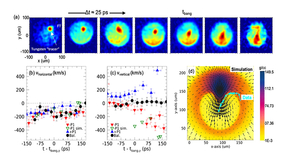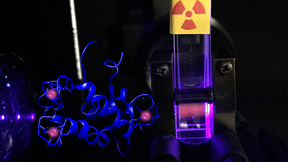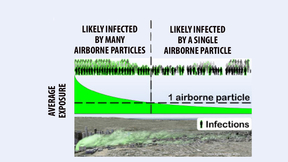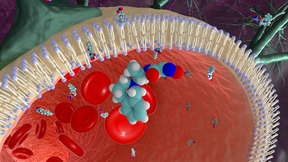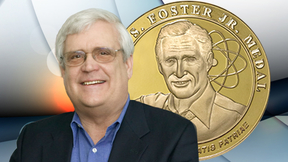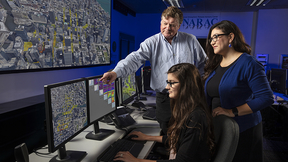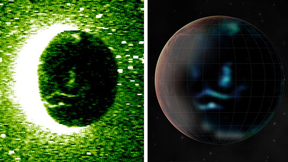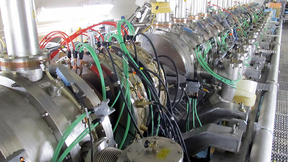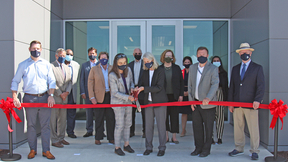Back
Science
A bigger nursery for the solar system’s first formed solids
The earliest solids formed in the solar system give clues to what radioactive species were made by the young sun, and which ones were inherited. By studying isotopic variations of the elements vanadium (V) and strontium (Sr), an international team of researchers including scientists from Lawrence Livermore National Laboratory (LLNL) found that those variations are not…
New research delves into fate of ocean carbon
Marine-dissolved organic matter, which originates from phytoplankton, holds as much carbon as Earth’s atmosphere, yet the biological processes governing its fate are primarily studied under idealized laboratory conditions or through indirect measures such as genome sequencing. In new research by a Lawrence Livermore National Laboratory (LLNL) scientist and collaborators at…
A new Virtual Discovery Center experience
For decades, Lawrence Livermore National Laboratory’s (LLNL’s) Discovery Center has served as a window into LLNL’s state-of-the-art research. With the center closed to the public during to the pandemic, the Lab has pivoted the Discovery Center experience from in-person to virtual. “LLNL is pleased to introduce the all-new Virtual Discovery Center,” said Joanna Albala, LLNL…
Lawrence Livermore researchers focus on fast flows in thermonuclear fusion
Imagine having a balloon between both hands and trying to squeeze it with the same force on all sides so that it uniformly shrinks down. However, if you push on one side harder than the other the balloon won’t compress uniformly and will, in fact, move away from the hand that is pushing harder. The same thing happens when the drive pushing on an inertial confinement fusion…
Come on in, the water is superionic
The interiors of Uranus and Neptune each contain about 50,000 times the amount of water in Earth’s oceans, and a form of water known as superionic water is believed to be stable at depths greater than approximately one-third of the radius of these ice giants. Superionic water is a phase of H2O where hydrogen atoms become liquid-like while oxygen atoms remain solid-like on…
LLNL explores laser beam shaping to improve metal 3D printing
While laser-based 3D printing techniques have revolutionized the production of metal parts by greatly expanding design complexity, the laser beams traditionally used in metal printing have drawbacks that can lead to defects and poor mechanical performance. Researchers at Lawrence Livermore National Laboratory (LLNL) are addressing the issue by exploring alternative shapes…
Inaugural industry forum inspires ML community
LLNL held its first-ever Machine Learning for Industry Forum (ML4I) on Aug. 10-12. Co-hosted by the Lab’s High Performance Computing Innovation Center (HPCIC) and Data Science Institute (DSI), the virtual event brought together more than 500 participants from the Department of Energy (DOE) complex, commercial companies, professional societies and academia. Industry…
Nuclear waste interaction in the environment may be more complicated than once thought
Lawrence Livermore National Laboratory (LLNL) scientists and collaborators have proposed a new mechanism by which nuclear waste could spread in the environment. The new findings, which involve researchers at Penn State and Harvard Medical School, have implications for nuclear waste management and environmental chemistry. The research is published in the Journal of the…
Manufacturing Day webinar highlights industry collaboration, emerging technologies
To celebrate Manufacturing Day 2021, the High Performance Computing for Energy Innovation (HPC4EI) initiative will hold a special webinar on Oct. 1 featuring speakers from the Department of Energy (DOE), presentations by DOE scientists and students and virtual tours. The free event runs from 7:30 a.m. to 12:30 p.m. PDT and is open to all. The webinar’s plenary session…
What if just one airborne particle was enough to infect you?
For some diseases, exposure to just a single airborne particle containing virus, bacteria or fungi can be infectious. When this happens, understanding and predicting airborne disease spread can be a whole lot easier. That’s the result of a new study by a Lawrence Livermore National Laboratory (LLNL) scientist who developed a new theory of airborne infectious disease spread…
Lawrence Livermore-led effort one of nine DOE-funded data reduction projects
A Lawrence Livermore National Laboratory-led effort in data compression was one of nine projects recently funded by the U.S. Department of Energy (DOE) for research aimed at shrinking the amount of data needed to advance scientific discovery. LLNL was among five DOE national laboratories to receive awards totaling $13.7 million for data reduction in scientific applications…
Lawrence Livermore develops promising antidote for nerve agent exposure
Scientists at Lawrence Livermore National Laboratory (LLNL) have developed a new, versatile antidote to counteract exposure to nerve agent poisoning. The work, appearing in the journal Scientific Reports, was the result of a highly iterative process built in collaboration between LLNL’s Global Security Directorate, its Forensic Science Center and the U.S. Army Medical…
George Miller selected for John S. Foster Medal for contributions to national security
Lawrence Livermore National Laboratory (LLNL) Director Emeritus George Miller has been named the 2021 recipient of the John S. Foster Medal for his contributions to U.S. national security. In recognition of his outstanding service to the nation, Miller has been named the sixth recipient of the medal. “I am extremely honored to receive the 2021 John S. Foster Award. Johnny…
The institutional response to 9/11 – with 'our track shoes on'
Editor's note: The following is part of a series of articles looking back at the Lab's response immediately following the Sept. 11 attacks and our contributions since that day 20 years ago. Lawrence Livermore National Laboratory’s (LLNL) “response” to the tragic events on Sept. 11, 2001, actually began in July 1992 with the formation of the Nonproliferation, Arms Control…
NARAC at forefront in a post-9/11 world
Editor’s note: The following is part of a series of articles looking back at the Lab's response immediately following the Sept. 11 attacks and our contributions since that day 20 years ago. From keeping Americans safe at national events to assisting with international disasters, Lawrence Livermore National Laboratory’s (LLNL) National Atmospheric Release Advisory Center …
How BASIS grew into the BioWatch system
Editor's note: The following is part of a series of articles looking back at the Lab's response immediately following the Sept. 11 attacks and our contributions since that day 20 years ago. Less than a month after 9/11, 14 Lawrence Livermore National Laboratory (LLNL) employees received calls at their homes at 1 a.m. on a Saturday morning (Oct. 6, 2001) and were asked to…
Lawrence Livermore optics used to spot elusive aurora on Red Planet
The United Arab Emirates' (UAE) Mars mission that launched about a year ago has recently captured the most detailed images of auroras in the Martian sky. The optics used to capture these images include a silicon carbide-coated mirror and diffraction grating for the Emirates Mars Ultraviolet Spectrometer (EMUS) that were developed by researchers at Lawrence Livermore…
Diagnostic capability allows scientists to create X-ray movies
Lawrence Livermore National Laboratory (LLNL) scientists are working on a new diagnostic capability that will provide, for the first time, the ability to make X-ray radiographic movies. The first experiment testing the principle, dubbed the Bipolar Reset Experiment (BIRX), was conducted at LLNL’s Flash X-Ray (FXR) deep-penetration radiographic facility at Site 300. The…
LLNL, NNSA and elected officials celebrate opening of Livermore Valley Open Campus expansion
Leaders from the National Nuclear Security Administration (NNSA), Congressional representatives and local elected officials gathered at Lawrence Livermore National Laboratory (LLNL) on Aug. 10 to celebrate an expansion to the Livermore Valley Open Campus (LVOC). The Lab hosted a ribbon-cutting ceremony for a new office building (Bldg. 642) and a conference annex (Bldg. 643…
Lawrence Livermore team captures data from unarmed Minuteman III test launch
A team from Lawrence Livermore National Laboratory (LLNL) successfully collected data from the recent operational test of an Air Force Global Strike Command unarmed Minuteman III intercontinental ballistic missile (ICBM) launched from Vandenberg Space Force Base. The purpose of the ICBM test launch program is to validate and verify the safety, security, effectiveness and…





